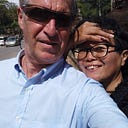The GBA: Attracting foreign investment and high caliber talent from all over the world
You can watch this as a video here: https://youtu.be/gWrjfl0Xpvs
I talked in a previous video about China’s policies to attract talent and thought it might be a good idea to take that one step further and explain what it means, especially what it means to Guangdong, and the Greater Bay Area.
140 years ago, a 29-year-old migrant called Nikolai Tesla arrived in New York, intelligent, well-educated but penniless. 50 years later, in 1933 Einstein arrived and, on the basis of Hitler’s ascension to power, decided to stay.
These are well known names but tens of thousands of less well-known names, some 1,600 German wartime researchers, many of them escaping war-crime prosecutions went to the USA through a thing called Operation Paperclip, shortly afterwards, a new word was invented in post-war Britain to describe the outflow of researchers and scientists to the USA, it was called the “Brain Drain”.
The US welcomed them with open arms, their inventions, discoveries and developments made America great. Through migration, employment and absorption of some of the best minds in modern history, the USA became the largest economy, with the greatest universities and the best technology in the modern world. But they also have the most powerful military and focus much of their attention to building that, very much to the detriment of their manufacturing and employment opportunities, most of which have been sent to countries where costs are lower and profits are higher and they’ve also allowed their domestic infrastructure to deteriorate.
As a result, the US has either been, or is in the process of being, overtaken in terms of technology and economy. The new “brain-drain” is to China.
Berkeley University identified a changing trend: China leads the world with 60% of all top tier researchers gaining their undergraduate degrees in China. But, until a few years ago, 56% of them were moving to America. This was beneficial to America but hugely detrimental to China.
China wants them back, Guangdong has issued a policy to attract them and now, many of them have already returned. Part of this related to Trump’s crackdown on Chinese students, now recognised as a policy error, but a significant factor is the reversal of what are known as the “push factors”. Historically, people left China because they were paid more elsewhere, the environment and lifestyles were better there, there was less pollution and better healthcare as well as more innovation opportunities. An additional “pull factor” for the US was a relatively easy residency process.
All this has changed, particularly in places such as Henqing near Macau, Qianhai, near Hong Kong and Nansha at the head of the Pearl River, where special rules apply: Foreign talent in China now have a much easier Chinese Green-card process and more Chinese are being enticed back due to changes in those push factors.
China’s environment has improved, pollution is a thing of the past, salaries are globally competitive while living expenses remain low. Health and lifestyle issues have been resolved with international standards in hospital care, living accommodation and globally recognised schools for families to send their kids to and, most importantly of all, China is now the global leader in innovation with the highest number of patent applications, scientific publications and it leads the world in many new technologies such as communications, AI, and sustainable development and plans to be ahead in Robotics in the next 5 years.
The US may not like it but even Berkeley University recognises it, China’s era of High-quality development is not just under way, it’s gathering momentum and will not stop anytime soon.
